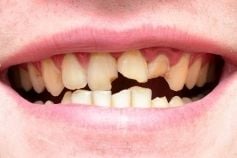 If you have chipped or broken teeth, you should speak to your dentist about the various tooth repair options. While tooth enamel is very strong, it can sustain damage due to a trauma. A blow to the mouth or biting down on something really hard can cause the enamel to break. If you ignore the break, it can lead to tooth decay. Invariably front teeth are the most vulnerable and if your front teeth are chipped or cracked, it will affect your self-confidence and reduce your ability to smile boldly. Let’s not forget the pain if the chip or crack is severe.
If you have chipped or broken teeth, you should speak to your dentist about the various tooth repair options. While tooth enamel is very strong, it can sustain damage due to a trauma. A blow to the mouth or biting down on something really hard can cause the enamel to break. If you ignore the break, it can lead to tooth decay. Invariably front teeth are the most vulnerable and if your front teeth are chipped or cracked, it will affect your self-confidence and reduce your ability to smile boldly. Let’s not forget the pain if the chip or crack is severe.
Thankfully, there are several ways to repair teeth that are broken or chipped. The option your dentist chooses will depend on the severity of damage.
Severity of Damage
For you, a chipped tooth is a chipped tooth. However, the severity can vary greatly. Sometimes just the superficial layer of the enamel get knocked off and at other times what seems like a chip could actually be a tooth fracture. If your tooth is fractured, you will notice a large portion of the crown missing and if the pulp is exposed, it will extremely painful.
All tooth repair options look at saving the functioning of the tooth besides restoring the enamel and dentine. When the damage to the tooth is severe, the dentist may opt first for a root canal treatment, wherein the pulp is completely removed and the root canals and pulp chamber is thoroughly cleaned and then filled with dental material to ward off infection.
Tooth Repair Options
Dental science has advanced substantially in the last few decades and there are a number of options to repair chipped and broken teeth. Some of the options are:
- Reshaping the tooth and polishing it
- Bonded composite filling
- Porcelain veneer
- Full crown
Reshaping the Tooth: If your tooth has chipped off slightly and just the superficial layer of the enamel has broken off without exposing the underlying dentine, the dentist will reshape it by using a high-speed drill and polishing discs. Besides this, no other treatment is required.
Bonded Composite Filling: If the enamel is chipped sufficiently to expose the dentine, the dentist will look to restore that part of the tooth that is lost. He will use bonded composite filling to restore the tooth. You needn’t worry, as the filling will be the same color as the rest of the tooth and no one will notice it. Even if the tooth is missing a large part of the enamel, it is possible to replace it with modern composite materials.
Porcelain Veneers: One of the biggest disadvantages with composite material is that it is porous and tends to discolor over a period of time. Hence, many dentists prefer to use porcelain. If the composite material does not bond properly with your tooth, the dentist will opt for porcelain veneer. It is a better option because it does not discolor and stays in place. To fix the veneer to your tooth, the dentist would first have to prepare the tooth and then attach the porcelain veneer to the front portion of your tooth. If the damaged tooth is a premolar or molar, the dentist will use a porcelain inlay. Whether it is a porcelain veneer or inlay, it would have to be custom-made for your tooth in a dental laboratory. Once the veneer is fixed with dental resin, the shape and size of your tooth will be restored.
Dental Crowns: If a large part of your tooth is missing or when porcelain veneer is not an option, the dentist will opt for a full crown, also known as cap in layman’s term. The crown will cover the tooth like a cap after it has been shaped to accept the crown. Porcelain crowns often are best suited, as porcelain can mimic the translucency of natural tooth. However, if you have a heavy bite, the dentist will use porcelain fused with metal to ensure a strong crown.
A chipped or broken tooth does not have to be a problem anymore. Speak to your dentist about the different tooth repair options and you will find one to suit your need and budget. Your chipped and broken tooth can be successfully restored to look normal and will even function like before. So what are you waiting for?




